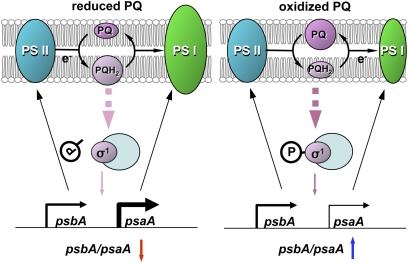Fig. 4.
Model of the photosynthetic control of chloroplast gene transcription via phosphorylation of a SIG. The redox status of PQ is changed by the intensity and wavelength of light: Irradiance or shorter-wavelength light (680 nm) generates PQH2, and low light or longer-wavelength light (700 nm) at sunrise and sunset oxidizes PQ. The chemically reduced form of PQH2 is produced by electron flow from PS-II and converted to PQ after electron flow to PS-I. Electron flow from PS-II to PQ can be inhibited by DCMU, and electron flow from PQ to PS-I can be inhibited by DBMIB. The expression of psaA, encoding the apoprotein of the PS-I reaction center, is induced by PQH2 and repressed when PQH2 is oxidized. The expression of psbA encoding the D1 protein of the PS-II reaction center is less affected by redox status. The core enzyme associated with dephosphorylated SIG has high transcriptional activity for psaA and psbA, and phosphorylation of SIG causes a greater reduction of the transcription of psaA than psbA.

